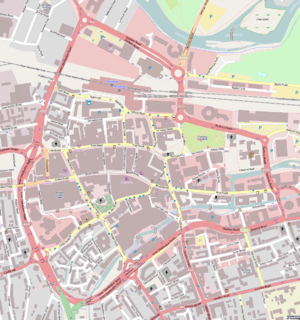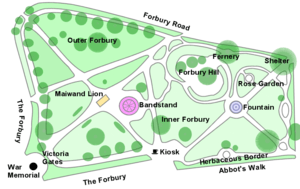Forbury Gardens
| Forbury Gardens | |
|---|---|
|
The Maiwand Lion | |
 Location within Reading Town Centre | |
| Type | Public |
| Location | Reading, Berkshire, UK |
| Coordinates | 51°27′25″N 0°58′2″W / 51.45694°N 0.96722°WCoordinates: 51°27′25″N 0°58′2″W / 51.45694°N 0.96722°W |
| Operated by | Borough of Reading |
Forbury Gardens is a public park in the town of Reading in the English county of Berkshire. The park is on the site of the outer court of Reading Abbey, which was in front of the Abbey Church. The site was formerly known as the Forbury, and one of the roads flanking the current gardens is still known as The Forbury. Fairs were held on the site three times a year until the 19th century.
Forbury, a suburb of the New Zealand city of Dunedin, was named after the gardens by early resident William Henry Valpy, who was born in Reading.[1]
History

Reading Abbey was founded in 1121, by Henry I, and for the next four centuries it dominated the town, becoming one of the most influential establishments in England. Like other such monasteries, Reading had a forbury, or 'borough in front', an area of open land which provided a meeting place between the Abbey and the town. The Forbury in Reading was part of the outer court of the Abbey, and provided a market place as well as a meeting place.[2]
In 1150, what is now Forbury Hill was constructed to help fortify the Abbey during the civil war between King Henry I's daughter, Matilda, and his nephew, Stephen.
The abbey was largely destroyed in 1538 during Henry VIII's Dissolution of the Monasteries. The last abbot, Hugh Cook Faringdon, was subsequently tried and convicted of high treason and hanged, drawn and quartered in front of the Abbey Church. After this, the buildings of the abbey were extensively robbed, with lead, glass and facing stones removed for reuse elsewhere, and the focus of the town moved away from the Forbury.[2][3]
Reading suffered badly during the English Civil War, being occupied at different time by both sides. During the Siege of Reading (1642-3), the Royalist garrison built defences that further damaged the remains of the Abbey, and Forbury Hill was used as a gun emplacement.[2]
As a result of the concerns sparked in England by the French Revolution, and throughout the ensuing Napoleonic Wars, the Forbury was used for military drills and parades, in addition to its well-established use for fairs and circuses. Three annual fairs were generally held on the Forbury, but the most significant was the Michaelmas Fair, held in September. This fair became known as the Reading Cheese Fair, although cattle, horses and hops were also sold, and it served as the principal local hiring fair.[4]
By the first years of the 19th century, the western part of the Forbury was in use as a playground or sports ground for Reading School, which at this time was housed in the former Hospitium of St John. However the whole of the Forbury was in private ownership, and disputes were common as to the common rights of the town and the rights of the school.[4][5]
In 1854, Forbury Hill and the eastern section of the present gardens were sold to Reading Corporation at the cost of £1200, of which £400 was donated by the previous owner, a Mr Wheble. The resulting gardens were planned with a 'botanical character', a fountain and a summer house, and became known as the Pleasure Gardens. Work started in 1855 and the Pleasure Gardens opened on Easter Sunday 1856. A tunnel was built on the eastern side in 1859 to link the gardens and the Abbey ruins.[4]
The success of the Pleasure Gardens contrasted with the situation in the western part of the Forbury, which was still used for fairs. After one fair, the area was described as being covered 'with heaps of oyster shells, manure and other refuse'. In 1860, this section of the Forbury was purchased by the town for £6010 from Colonel Blagrave. It was decided that fairs should no longer be held there, but the emphasis remained on recreational use rather than botanical display, with the area grassed except for the outside walks and a gravelled parade ground.[4]
The common ownership notwithstanding, the two halves of the Forbury remained very different in character, and separated by a wall. However in 1869 the town purchased 12 acres (4.9 ha) of King's Meadow, the abbey's former water meadow by the River Thames, as a recreation ground. This paved the way for the incorporation, in 1873, of the western part of the Forbury into the gardens, which then became known as Forbury Gardens.[4]
The Maiwand Lion statue was erected in 1886 to commemorate the loss of 286 soldiers (though the exact number varies by account) from the 66th Royal Berkshire Regiment at the Battle of Maiwand in Afghanistan on the 27 July 1880.[6][7] The sculptor of this 31-foot statue was George Blackall Simonds and was unveiled in December 1886.[7] It is sometimes known locally as the Forbury Lion.[8]
A cross memorializing Henry I was put up, at about the same time as the Maiwand Lion, on the north-west corner of the footings of the Abbey Church. The Victoria Gates on the southern side of the gardens commemorate Queen Victoria's Diamond Jubilee in 1897. The shields on the gates are those of the Borough and the Abbey.
The gardens today

A grand re-opening event took place on May 14, 2005, to mark the completion of a one-year restoration project. The Heritage Lottery Fund awarded Reading Borough Council £2.13 million to restore the historic features of the Forbury Gardens and improve safety and access for visitors. The scheme was developed in consultation with residents and interested local groups.[9]
Work in the gardens themselves has included the restoration of the Maiwand Lion, the bandstand, water feature and the garden's walls, fencing and gateways. A new Keeper's Lodge also includes a refreshment kiosk, public toilets and facilities for a resident gardener. Reading Borough Council organises summer concerts in the bandstand on Sunday afternoons during July and August.[9][10][11]
After the restoration, closed-circuit cameras monitor the whole Gardens area, in a bid to deter the drug users and other miscreants that used to make ordinary people fearful of using the public gardens. The garden has received a Green Flag Award for being welcoming, safe, well maintained and involving the community.
Forbury Gardens is home to Reading's YouTube gatherings, which are frequently held throughout the year. These gatherings are known as 'Sassy' and then would either have the name of the month or a celebration, e.g. Christmas. Forbury Garden's largest YouTube gathering was in June 2013, an estimated 200 people attended, although there was an expected number of at least 500 people to descend on the gardens.[12]
The Forbury Hill is now accessible by two winding footpaths (wheelchair-accessible) that lead to an area that is elevated about 3 metres above the surrounding gardens. A single plane tree stands in the middle, and around the outer edge of the top of the hill are wooden seats.[13]
It was announced in May 2014 that the gardens will be the site of the Trooper Fred Potts VC statue.[14]

References
- ↑ "William Henry Valpy (1793-1852)". The Caversham Project. University of Otago. Retrieved 2011-01-19.
- ↑ 2.0 2.1 2.2 "History of Forbury Gardens". Reading Borough Council. Retrieved 2011-01-20.
- ↑ The staff of the Trust for Wessex Archeology and Reading Museum and Art Gallery (1983). Reading Abbey Rediscovered: a summary of the Abbey's history and recent archaeological excavations. Trust for Wessex Archeology.
- ↑ 4.0 4.1 4.2 4.3 4.4 Slade, Cecil (2001). The Town of Reading and its Abbey. MRM Associates Ltd. pp. 71–93. ISBN 0-9517719-4-9.
- ↑ Phillips, Daphne (1980). The Story of Reading. Countryside Books. p. 42. ISBN 0-905392-07-8.
- ↑ "The Maiwand Lion". bbc.co.uk. Retrieved 2013-06-02.
- ↑ 7.0 7.1 "The history of the Maiwand Lion". bbc.co.uk. Retrieved 2013-06-02.
- ↑ "Maiwand Lion – Forbury Gardens, Reading" (PDF). Reading Museums. Archived from the original (PDF) on 2007-09-28. Retrieved 2007-11-26.
- ↑ 9.0 9.1 "Forbury Gardens Restoration Project". Reading Borough Council. Retrieved 2011-01-19.
- ↑ "Forbury Gardens Restoration Project - Project Update June 2004". Reading Borough Council. Retrieved 2011-01-19.
- ↑ "Forbury Gardens to be Filled With the Sound of Music". Reading Borough Council. Retrieved 2011-01-19.
- ↑ "Town Centre Gardens Retains Green Flag Status". Reading Borough Council. 2007-07-18.
- ↑ "Restoration Proposals Overall Plan" (PDF). Reading Borough Council. Retrieved 2011-01-20.
- ↑ http://www.readingchronicle.co.uk/news/reading/articles/2014/05/01/99868-site-revealed-for-readings-only-victoria-cross-winner-trooper-potts/
External links
| Wikimedia Commons has media related to Forbury Gardens. |
